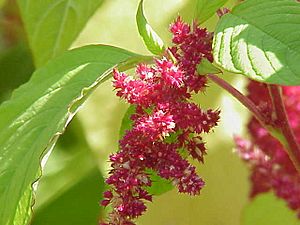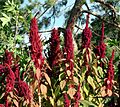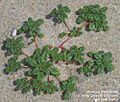Amaranth facts for kids
Quick facts for kids Amaranthus |
|
|---|---|
 |
|
| Amaranthus tricolor | |
| Scientific classification | |
| Kingdom: | |
| Division: | |
| Class: | |
| Order: | |
| Family: | |
| Genus: |
Amaranthus
|
Amaranth (Amaranthus species) is a group of plants found all over the world. There are about 60 different kinds of amaranth. These plants have pretty flowers and leaves that can be purple, red, or even gold!
Even though some people think amaranth is just a weed, it's actually a very important plant. People grow amaranth for its healthy leaves, its tiny seeds (which are like grains), and sometimes just because it looks beautiful in gardens.
Contents
What is Amaranth?
Amaranth plants belong to a family called Amaranthaceae. They are known for their colorful leaves and often tall, bushy growth. Some types of amaranth can grow very quickly. They are quite tough plants and can grow in many different climates. This is why you can find them almost everywhere!
A Plant with Many Uses
Amaranth is special because different parts of the plant can be used in many ways.
As a Leafy Green
Many cultures eat amaranth leaves as a leafy vegetable. They are often cooked like spinach. Amaranth leaves are packed with vitamins and minerals. They are a great source of iron and calcium. In places like Africa, Asia, and the Caribbean, amaranth leaves are a common part of meals.
As a Cereal or Pseudocereal
The tiny seeds of amaranth plants are also very useful. They are not true cereals like wheat or rice. Instead, they are called "pseudocereals." This means they are used like grains. Amaranth seeds are gluten-free, which is good for people who cannot eat gluten. They are also full of protein, fiber, and important nutrients.
People can pop amaranth seeds like popcorn. They can also grind them into flour for baking. In Mexico, a sweet treat called Alegría is made from popped amaranth and honey. Amaranth seeds have been an important food for thousands of years. Ancient civilizations like the Aztecs and Incas grew amaranth.
As an Ornamental Plant
Some types of amaranth are grown just for their beauty. Their bright colors and interesting shapes make them popular in gardens. For example, Amaranthus caudatus is known as "Love-lies-bleeding." It has long, drooping clusters of red flowers. These plants add a lot of color to flower beds.
Where Does Amaranth Grow?
Amaranth is found on almost every continent. It grows well in warm climates. Some types are even found in cooler areas. This plant is very adaptable. It can grow in different types of soil. This makes it easy to cultivate in many parts of the world.
Amaranth's History
Amaranth has a long and rich history. It was a very important crop for ancient civilizations in the Americas. The Aztecs, Mayans, and Incas grew amaranth thousands of years ago. They used it as a main food source. It was also used in religious ceremonies.
After the Spanish arrived in the Americas, amaranth farming decreased. But in recent years, people have rediscovered its value. Now, amaranth is becoming popular again. People around the world are learning about its health benefits and many uses.
Images for kids
-
Amaranth grain (left) and wheat (right)
-
Southern Kerala-style traditional Thoran made with Cheera (amaranth) leaves
-
Love-lies-bleeding (A. caudatus)
-
Seabeach amaranth (A. pumilus), an amaranth on the Federal Threatened species List
-
Spiny amaranth (A. spinosus)
-
Green amaranth (A. viridis)
-
Amaranth from Chilpancingo
See also
 In Spanish: Amaranto para niños
In Spanish: Amaranto para niños












